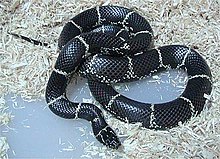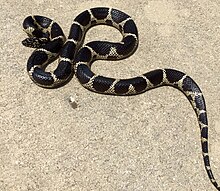Lampropeltis getula
| Eastern kingsnake | |
|---|---|

| |
| Scientific classification | |
| Domain: | Eukaryota |
| Kingdom: | Animalia |
| Phylum: | Chordata |
| Class: | Reptilia |
| Order: | Squamata |
| Suborder: | Serpentes |
| Family: | Colubridae |
| Genus: | Lampropeltis |
| Species: | L. getula
|
| Binomial name | |
| Lampropeltis getula (Linnaeus, 1766)
| |
| Synonyms[2] | |
| |
Lampropeltis getula, commonly known as the eastern kingsnake,
Description


Adult specimens of the speckled kingsnake, L. g. holbrooki, are the smallest race at 91.5 cm (36.0 in) in snout-to-vent length (SVL) on average, while L. g. getula is the largest at 107 cm (42 in) SVL on average.[7] Specimens up to 208.2 cm (82.0 in) in total length (including tail) have been recorded.[8] Weight can vary from 285 g (10.1 oz) in a small specimen of 87.2 cm (34.3 in) in total length, to 2,268 g (80.0 oz) in large specimens, of over 153 cm (60 in) in total length.[7][9]
The color pattern consists of a glossy black, blue black, or dark brown ground color, overlaid with a series of 23-52 white chain-like rings.[5][10] Kingsnakes from the coastal plains have wider bands, while those found in mountainous areas have thinner bands or may be completely black.[citation needed]
Common names
Common names for L. getula include eastern kingsnake,[3] common kingsnake,[4] chain kingsnake,[5] kingsnake, Carolina kingsnake, chain snake, bastard horn snake, black kingsnake, black moccasin, common chain snake, cow sucker, horse racer, master snake, North American kingsnake, oakleaf rattler, pied snake, pine snake, racer, rattlesnake pilot, thunder-and-lightning snake, thunderbolt, thunder snake, wamper, wampum snake.[10]
Geographic range
L. getula is found in the United States in Alabama, Arizona, Arkansas, California, portions of Colorado, Delaware, Florida, Georgia, south and southwest Illinois, southern Indiana, southern Iowa, Kansas, Kentucky, Louisiana, Maryland, Mississippi, Missouri, Nebraska, southern and western Nevada, New Jersey, New Mexico, New York, North Carolina, southern Ohio, Oklahoma, southern Oregon, South Carolina, Tennessee, Texas, southern Utah, Virginia, and West Virginia. It is also found in northern Mexico, including all of Baja California.[2] It has been introduced to Gran Canaria in the Canary Islands, where in 2014, the population had reached an estimated 20,000 individuals.[11]
Habitat
The preferred
Although commonly described as diurnal, some reports suggest that the Eastern Kingsnake are crepuscular or nocturnal during the hottest parts of the year.[13] They will often retreat into rodent burrows as nocturnal retreats.[14]
It has been found that Eastern Kingsnake home ranges often show little-to-no overlap.[15]
Some studies show that Eastern Kingsnakes (L. g. getula), especially males, are territorial, and will engage invading snakes in combat if their territory is threatened.[15]
Diet
L. getula eats other snakes, including venomous snakes such as copperheads (
It has developed a hunting technique to avoid being bitten by clamping down on the jaws of the venomous prey,[
Due to their diet of eating other snake species, kingsnakes are a key factor in the spread of ophidiomycosis. This is a relatively new snake fungal disease originating from the fungus, Ophidiomyces ophiodiicola. This disease has a variety of impacts on snakes and the extent of this impact is still being researched.[18]
Reproduction
L. getula is oviparous. Adult females lay up to several dozen eggs that hatch after 2.0-2.5 months of incubation. Hatchlings are brightly colored and feed on small snakes, lizards, and rodents.[5] Eastern Kingsnakes (L. g. getula) are active from April–October in most parts of their habitat range and breeding occurs in the spring months.[19] Neck-biting is a common behavior when mating.[20]
In captivity
Long a favorite among collectors, L. getula does well in captivity, living to 25 years or more. Some of the most popular subspecies of the common kingsnake kept in captivity are the California, Brooks', Florida, and Mexican black kingsnakes.[5]
Subspecies
| Subspecies[6] | Authority[6] | Common name[6] | range |
|---|---|---|---|
| L. g. brooksi | Barbour, 1919 | Brooks's kingsnake | |
| L. g. floridana | Blanchard, 1919 | Florida kingsnake | |
| L. g. getula | (Linnaeus, 1766) | eastern kingsnake | |
| L. g. nigrita | Zweifel & Norris, 1955 | Mexican black kingsnake | |
| L. g. meansi | Krysko & Judd, 2006 | Apalachicola Lowlands kingsnake | the Apalachicola Lowlands, Florida |
References
- . Retrieved November 19, 2021.
- ^ a b Lampropeltis getula at the Reptarium.cz Reptile Database. Accessed June 29, 2008 {{{year}}}.
- ^ ISBN 0-395-19977-8(paperback). (Lampropeltis getulus getulus, p. 202).
- ^ ISBN 0-394-50824-6. (Lampropeltis getulus, pp. 618-620).
- ^ ISBN 0-8069-6460-X.
- ^ a b c d "Lampropeltis getula". Integrated Taxonomic Information System. Retrieved June 29, 2008.
- ^ a b "Lampropeltis getula (Common Kingsnake)".
- ^ "Lampropeltis getula getula". www.flmnh.ufl.edu. Archived from the original on February 24, 2001.
- ^ "Archived copy" (PDF). Archived from the original (PDF) on July 14, 2014. Retrieved July 26, 2012.
{{cite web}}: CS1 maint: archived copy as title (link) - ^ ISBN 0-8014-0463-0. (Lampropeltis getulus getulus, pp. 372-376).
- ISBN 9780691170763.
- S2CID 84312480.
- ^ Howze, Jennifer & Smith, Lora. (2012). Factors Influencing Eastern Kingsnake Diel Activity. Copeia. 2012. 460-464. 10.2307/23273252.
- ISSN 0733-1347.
- ^ S2CID 85945120.
- ^ a b c d e "Lampropeltis getula (Common Kingsnake)". Animal Diversity Web.
- ^ Schmidt KP, Davis DD (1941). Field Book of Snakes of the United States and Canada. New York: G.P. Putnam's Sons. 365 pp. (Lampropeltis getulus, "Food", p. 176).
- PMID 34136555.
- S2CID 84312480.)
{{cite journal}}: CS1 maint: multiple names: authors list (link - ISSN 0022-1309.
Further reading
- ISBN 978-0975464113.
- Linnaeus C (1766). Systema naturæ per regna tria naturæ, secundum classes, ordines, genera, species, cum characteribus, differentiis, synonymis, locis. Tomus I. Editio Duodecima, Reformata. Stockholm: L. Salvius. 532 pp. (Coluber getulus, new species, p. 382). (in Latin).
- ISBN 978-0-544-12997-9. (Lampropeltis getula, p. 379 + Plate 34).
- ISBN 0-307-47009-1(hardcover). (Lampropeltis getula, pp. 180–181).
- ISBN 978-0-395-98272-3. (Lampropeltis getula, pp. 364–366 + Plate 44 + Map 153).
External links
- Lampropeltis getula at the Reptarium.cz Reptile Database. Accessed July 14, 2008 {{{year}}}.
- Eastern Kingsnake at the Florida Museum of Natural History. Accessed June 29, 2008.

